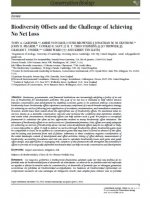Biodiversity Offsets and the Challenge of Achieving No Net Loss
By Toby Gardner, Amrei von Hase - International Institute for Sustainability, Forest Trends View PublicationBusinesses, governments, and financial institutions are increasingly adopting a policy of no net
loss of biodiversity for development activities. The goal of no net loss is intended to help relieve tension
between conservation and development by enabling economic gains to be achieved without concomitant
biodiversity losses. biodiversity offsets represent a necessary component of a much broader mitigation strategy
for achieving no net loss following prior application of avoidance, minimization, and remediation measures.
However, doubts have been raised about the appropriate use of biodiversity offsets. We examined what no
net loss means as a desirable conservation outcome and reviewed the conditions that determine whether,
and under what circumstances, biodiversity offsets can help achieve such a goal. We propose a conceptual
framework to substitute the often ad hoc approaches evident in many biodiversity offset initiatives. The
relevance of biodiversity offsets to no net loss rests on 2 fundamental premises. First, offsets are rarely adequate
for achieving no net loss of biodiversity alone. Second, some development effects may be too difficult or risky,
or even impossible, to offset. To help to deliver no net loss through biodiversity offsets, biodiversity gains must
be comparable to losses, be in addition to conservation gains that may have occurred in absence of the offset,
and be lasting and protected from risk of failure. Adherence to these conditions requires consideration of
the wider landscape context of development and offset activities, timing of offset delivery, measurement of
biodiversity, accounting procedures and rule sets used to calculate biodiversity losses and gains and guide
offset design, and approaches to managing risk. Adoption of this framework will strengthen the potential for
offsets to provide an ecologically defensible mechanism that can help reconcile conservation and development.

